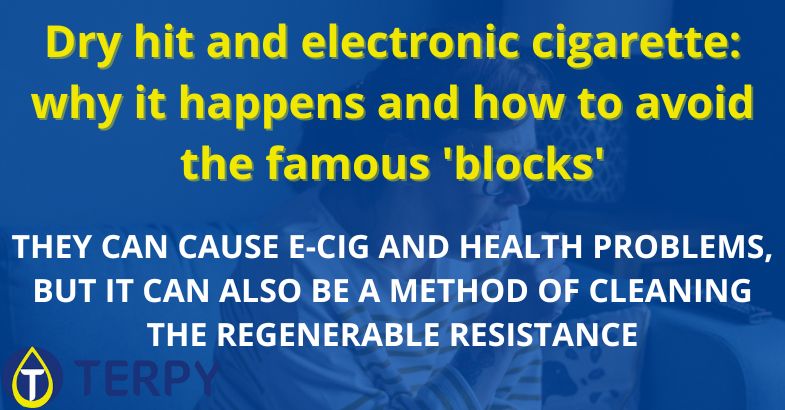Modified on: 24/05/2024
THEY CAN CAUSE E-CIG AND HEALTH PROBLEMS, BUT IT CAN ALSO BE A METHOD OF CLEANING THE REGENERABLE RESISTANCE
It can happen to novice vapers, but also to experts, and the sensation is anything but pleasant: we are talking about the “cue” or, to put it in technical terms, the dry hit.
This is a common problem, but in the long term it can damage the e-cig and force you to change parts of the device. Alternatively, it can be a cleaning practice for the e-cigarette.
So let’s see why it happens and, above all, how to avoid the involuntary dry hit.
Read also: Caffeine e-cigarette liquids: why avoid them
What is dry hit and why does it occur
Also called “dry burn“, dry hit can be translated as “dry combustion” and occurs when you use the e-cig without liquid or without a cotton wick in place. The involuntary dry hit occurs precisely when the liquid has run out or the cotton is dry or poorly positioned.
The sensation is unpleasant, leaves a bitter taste in the mouth and ruins the resistances, forcing them to be replaced more frequently.
Many suggest doing dry hits to clean and prolong the life of the resistors. As the liquid cools, it tends to encrust on the coil: these encrustations risk altering the flavor of the liquids themselves, compromising the vaping experience.


Dry combustion, in this case, serves to eliminate encrustations and clean the heating elements, thus prolonging their life. This “technique” is also used to check the coils and resistive wires and make sure that everything is working.
The voluntary dry hit, however, must only be done with regenerable atomizers and never with replaceable resistors: the risk is ruining the resistor and not regenerating it. Furthermore, it must be avoided in the presence of materials such as wick and mesh.
Clearly, the involuntary dry hit is a completely different matter: inhaling the vapor produced by the encrustations is harmful to your health, as well as to the electronic cigarette, and very unpleasant to the taste, given that you are inhaling liquid that is already burnt and sedimented. Furthermore, the overheating of the “dry” resistors could lead to the alteration of the metal and the release of microparticles.
How to avoid dry hit in the electronic cigarette
Having clarified the difference between voluntary dry hit and involuntary dry hit, here are some useful suggestions for avoiding dry burning, which, as mentioned, is a problem for e-cigs and for your health.
Refill the tank regularly: a triviality, but before starting to vape let’s make sure we have enough liquid in the tank;
Replace the resistors: even if you practice the voluntary dry hit to regenerate the resistors, it is a good idea to replace them with a certain frequency, as well as all the other parts of the electronic cigarette subject to wear;
Use the right type of liquid: another seemingly trivial aspect, the choice of quality liquids suitable for your e-cig model is essential to avoid excessive encrustations and sedimentation;
Change the power: dry hit can also be caused by too low power. You need to check the vaping power and adjust it to avoid vaping problems;
Moisten the resistance before use;
Use the electronic cigarette regularly: if not used, the encrustations that will form on the resistance accumulate, making cleaning difficult;
Clean the electronic cigarette regularly: regular cleaning, as well as use, allows you to keep all parts of the e-cig in good condition, including the resistance;
Change worn or old parts: as mentioned, non-regenerable resistors must be replaced with good frequency to avoid operating problems;
Keep the electronic cigarette away from humidity as well as heat sources.All this serves not only to avoid dry hit, but a series of problems that can compromise the functioning of the electronic cigarette and damage the health of the vaper.
Read also: How the e-cigarette is helping New Zealand’s fight against smoking


Voluntary dry hit: how it works
“What if I wanted to use the dry hit to clean the resistance instead?”
Meanwhile, first of all, if you are not particularly expert, get help from a more prepared person, who has been vaping for a longer time and has already used this method to clean the resistance and realign the coils of the resistance.
The operation itself is not complex and involves a few steps. First of all, the e-cig tank must be completely emptied and then unscrewed. The wick must then be removed from the resistance. At this point, you can activate the vaping function with a power slightly higher than that used for vaping, but without overheating it and, be careful, without inhaling at all. To remove deposits, you can use a brush. When the resistive wires return to the color of silver, the cleaning is complete.
That said, if you have any insecurity about the procedure, avoid the dry hit: remember that it can be harmful to both the electronic cigarette and your health.
In conclusion
Dry hit, also called dry burn or dry combustion, is a “stunt” that can occur during vaping: it can cause damage to the resistance of the e-cig and also to your health, given that you would end up sucking in encrusted liquid deposits on resistance.
Many recommend dry hit as a cleaning system for regenerable resistors (but not disposable resistors!): the process is not difficult, but it is a good idea to get advice from someone more experienced and proceed carefully.
To avoid involuntary dry hits, check the correct functioning of all parts of the e-cig, change the resistors often, fill the tank regularly with e-liquid and use an adequate power for vaping.





